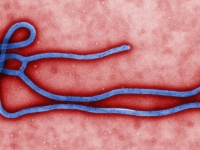Health
Ebola outbreak `continues to accelerate` as death toll tops 1,550
USPA News -
The Ebola outbreak in West Africa continues to accelerate with nearly 40 percent of all cases occurring this month alone, pushing the overall death toll from the four affected countries to 1,552, though the World Health Organization (WHO) believes the actual numbers are far higher. The new death toll came as the World Health Organization issued a "roadmap" to guide and coordinate the international response to the Ebola outbreak, which has affected Guinea, Liberia, Sierra Leone and Nigeria.
The 27-page document is intended to serve as a framework for updating detailed operational plans, the organization aid. But while Thursday`s update put the overall number of cases at 3,069, including 1,552 deaths, the World Health Organization believes the actual numbers are far higher. "This Roadmap assumes that in many areas of intense transmission the actual number of cases may be 2-4 fold higher than that currently reported," the document said, indicating the number of cases could already be as high as 12,300. Experts believe it will take many months to bring the devastating Ebola outbreak under control, and Thursday`s roadmap aims to stop the ongoing transmission within 6 to 9 months while rapidly managing the consequences of any further international spread. It also recognizes the need to address the outbreak`s socioeconomic impact. "Ebola could exceed 20,000 [cases] over the course of this emergency," the roadmap document said. "This plan recognizes that a number of currently unaffected countries could be exposed to Ebola, but assumed that the emergency application of the standard control strategies will stop any new transmission within 8 weeks of the index case." The report said operational plans will give priority to needs for treatment and management centers, social mobilization, and safe burials. These plans will be based on site-specific data that is being set out in regular situation reports, which the World Health Organization will start issuing this week. "The situation reports map the hotspots and hot zones, present epidemiological data showing how the outbreak is evolving over time, and communicate what is known about the location of treatment facilities and laboratories, together with data needed to support other elements of the roadmap," WHO said in a statement. Doctors Without Borders (Médecins Sans Frontières/MSF), which is one of the few international aid organizations that is treating Ebola patients, welcomed the roadmap but said it should not give a false sense of hope. "A plan needs to be acted upon. Huge questions remain about who will implement the elements in the plan," said MSF Director of Operations Brice de le Vingne. De le Vingne added: "We cannot escape the need to rapidly and effectively contain this epidemic and provide the necessary care to patients, their families, and affected communities. As an international public health emergency, states with the capacity to help have the responsibility to mobilize resources to the affected countries, rather than watching from the sidelines with a naive hope that the situation will improve." WHO`s latest figures released on Thursday showed the overall number of cases had reached 3,069, up by 454 over a 6-day period that ended on Tuesday. The death toll increased by 125 to 1,552 during the same period. Liberia was the worst affected country with 296 new cases and 70 deaths, followed by Sierra Leone with 116 new cases and 30 deaths, Guinea with 41 new cases and 24 deaths, and Nigeria with 1 new case and 1 death. "The outbreak continues to accelerate. More than 40% of the total number of cases have occurred within the past 21 days. However, most cases are concentrated in only a few localities," the World Health Organization said in its update. It said the overall case fatality rate so far is about 52 percent, though it is higher in some areas. The Ebola outbreak in West Africa is believed to have started in December 2013 in Guinea, but it was not detected until March, after which it spread to Liberia, Sierra Leone and, more recently, Nigeria. The current outbreak features the Zaire strain of the Ebola virus, which is considered the most aggressive and deadly strain, having killed up to 9 out of 10 infected in previous outbreaks. Ebola is a highly infectious disease and kills its victims in a very short time. Signs and symptoms include high grade fever, vomiting, diarrhea, abdominal pain, headache, measles-like rash, red eyes and, in some cases, bleeding from body openings. The ongoing outbreak is the worst ever of its kind and coincides with an unrelated Ebola outbreak in the Democratic Republic of Congo. The virus, for which there is no cure or vaccine, can spread through direct contact with body fluids such as saliva, blood, stool, vomit, urine, and sweat but also through soiled linen used by an infected person. It can also spread by using skin piercing instruments previously used by an infected person or by touching the body of a person who died of Ebola. It is not airborne. The first outbreak of Ebola in 1976 in Zaire - which is now the Democratic Republic of Congo - had been the deadliest until the current outbreak, killing at least 280 people and sickening 38 others, putting the fatality rate at 88 percent. The Ebola outbreak in Uganda in 2000 had long been the largest ever recorded, killing 224 people and sickening at least 201 others.
Liability for this article lies with the author, who also holds the copyright. Editorial content from USPA may be quoted on other websites as long as the quote comprises no more than 5% of the entire text, is marked as such and the source is named (via hyperlink).






